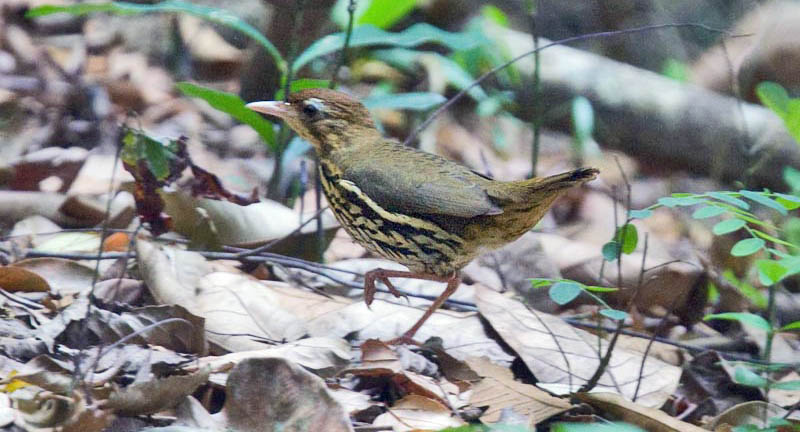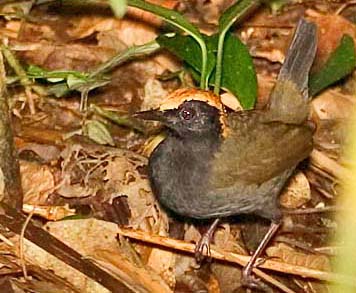
a web page by Don Roberson |
ANTTHRUSHES Formicariidae |
|
Antthrushes are found from southern Mexico to northern Argentina. Some are local, but others, like Rufous-capped Antthrush (left, in a fine shot by Arthur Grosset) are widespread in the Amazon Basin. It and Black-faced Antthrush Formicarius analis have the most widespread ranges. There are two genera of antthrush, each with six species: Formicarius and Chamaeza. However, there are enough unanswered taxonomic issues that further splits in some taxa may be considered likely. A species in the latter genus that I have seen, and found to be very impressive, is Short-tailed Antthrush (below in another nice Arthur Grossett photo). |
 |
Antthrushes were once considered part of the huge Antbird family [Thamnophilidae]; indeed, the groups remained merged through the 20th century. By the time that the Handbook of the Birds of the World series reached the suboscines, there was enough published evidence to split the unique "ground-antbirds" — the antpittas and the antthrushes — from the rest of the antbirds, and the "ground-antbirds" appeared together in HBW as a new family, the Formicariidae (Krabbe & Schulenberg 2003). Those authors, however, were already citing new genetic work that would lead to a quick break-up of the "ground-antbird" assemblage. Recent genetic work (e.g., Irestedt et al. 2002, Chesser 2004b, and others) showed that there were three distinct lineages in the "Formicariidae." The South American and North American checklist committees have handled this by restricting Formicariidae to just two genera of antthrushes [Formicarius, Chamaeza]; creating the family Grallariidae for all antpittas except the genus Pittasoma; and assigned the two species of Pittasoma antpitta to the Gnateaters [Rhinocryptidae]. More discussion of this split is on the Antpitta family page. Antthrushes, as now restricted to the two genera, are all hard-to-see birds of the forest floor. In looking through my my checklists, I see that half of the antthrushes I've seen were "seen poorly" walking in the undergrowth, but each was giving characteristics vocalizations. When actually seen well, they are quite stunning! |
Photos: Arthur Grosset photographed the Rufous-capped Antthrush Formicarius colma in Amazonian Brazil; he photographed the Short-tailed Antthrush Chamaeza campanisona at Serra do Barurita, Brazil, on 19 Oct 2008. Photos © Arthur Grosset, used with permission; all rights reserved. More of Arthur's excellent photos are on his web site. Bibliographic note: There is no "family book" per se, but a fine introduction to this family, with some great photos, is in Krabbe & Schulenberg (2003), although at that time the antpittas were lumped with antthrushes. The authors discuss all the evidence then available (e.g., Irestedt et al. 2002) and anticipate the results of others (e.g., Chesser 2004). Thus the overview on Antpittas is quite current there, despite the now-discarded merger with antthrushes. Literature cited:
|
 Walking
deliberately on the jungle floor, flicking leaves and pumping their
tail, and recalling a rail, antthrushes are characteristic denizens of
Neotropical lowland forests. They give whistled songs while walking,
often 10-20 seconds in length, and consisting of up to 200 notes of
similar quality, but often increasing in volume and pitch. Some species
have easily imitated songs.
Walking
deliberately on the jungle floor, flicking leaves and pumping their
tail, and recalling a rail, antthrushes are characteristic denizens of
Neotropical lowland forests. They give whistled songs while walking,
often 10-20 seconds in length, and consisting of up to 200 notes of
similar quality, but often increasing in volume and pitch. Some species
have easily imitated songs.